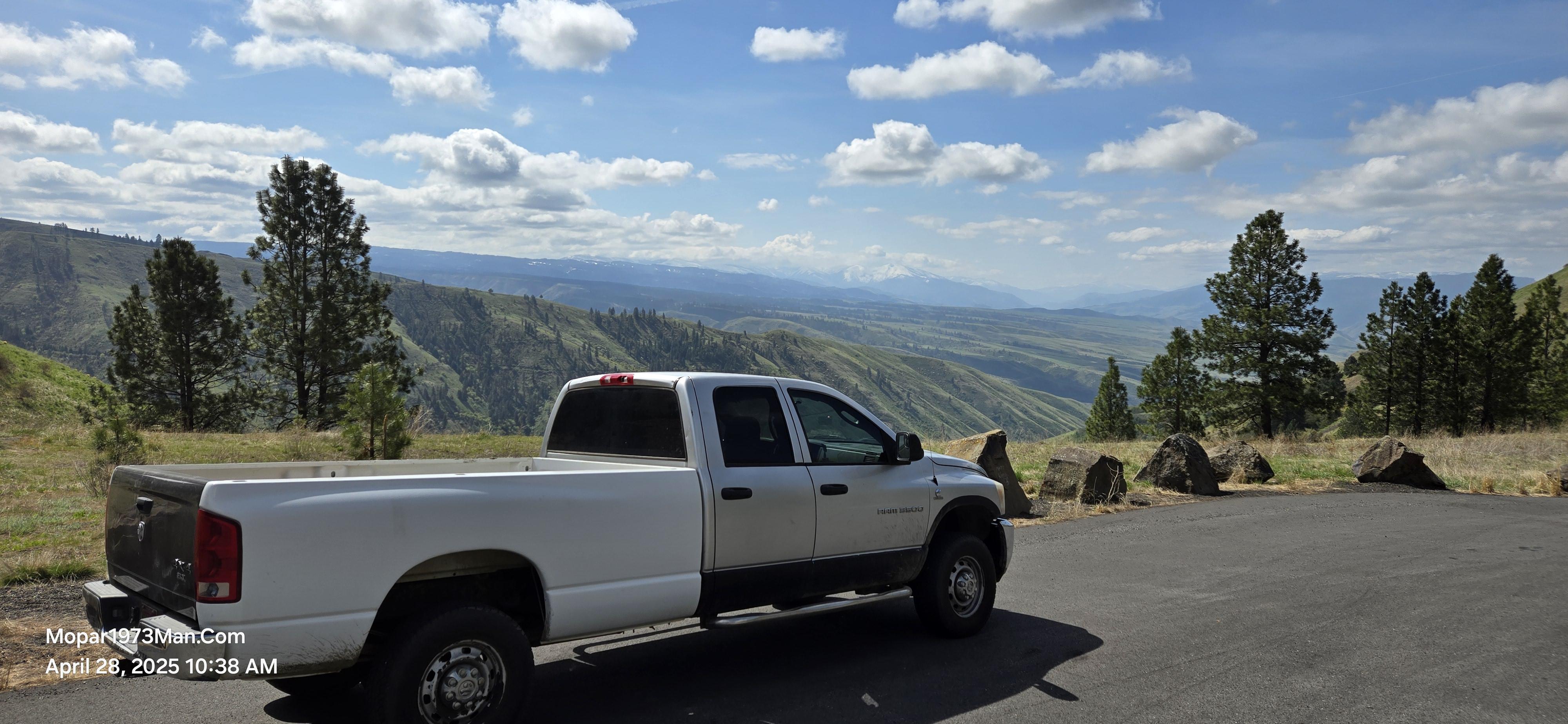
Everything posted by Mopar1973Man
-
Market for used injectors?
Holy cow... Too steep for my blood.
-
Truck bucking
I run 25% load limit on cruise timing.
-
Truck bucking
293 Bar is the lower limit. 310 Bar = 4,500 PSI 320 Bar = 4,641 PSI Max limit is 327 Bar according to the Dodge FSM. Adding the extra 10 Bar improved the spray starts super easy in the cold. Then it extends the life span of the injectors since when you dip below 280 Bar you'll start to see misfire at hot idle. Remember VP44 could produce pressures as high as 20,000 PSI at wide open.
-
Consensus-Greasing Wheel Bearings (ABS Port)
Not what I'm saying grease is only the carrier for the wear metals. I termed it graphite but that what it looks like after the bearing has worn down some and has that grey metal with small fine dust of metals in it. Regardless of what grease the wear metals will be in the grease later.
-
Consensus-Greasing Wheel Bearings (ABS Port)
Not so much what the grease is made from but how the metals of the bearing load the grease over time. Its a hall effect sensor on the ABS and if the sensor can't detect the teeth because of other metals (wear metals) filling the gaps of the tone wheel teeth in the grease then the ABS light will be set. Yeah I would prefer to have the old school cone and race that you can hand pack the bearings. I'm not going to do the expensive hub change over to get it as well as having manual hubs to shift in all the time. Again majority of the bearing failure is oversized tires and heavy offset wheel that add leverage forces and wear the bearings out quicker. I've got a conversation with another gent on TikTok about the failure that came in his shop which again had the heavy offset wheels and wide tires. Premature bearing failure will occur. As for me I go 180k to 200k on front unit bearings since I've never oversized, but undersized my tires. Never have to grease the bearings or worry about it.
-
Received my winter cover today!
My last video I made has the winter fronts in my grill. https://www.tiktok.com/t/ZTR4YyWpU/
-
gen 3 hemi supercharger systems.
Yeah I would love to know when you race next I'll go down and watch. With winter here it might be awhile.
-
Slight acceleration hesitation when cold
Also running 7 x 0.010 injectors on a stock HX35W turbo no issues. Typically run level 3 but very capable of running wire tap levels too. Final ratio will determine if EGTs get out of control. I'm running 245s (30.t inch] on 3.55 gears which makes 3.69 final ratio. Just fun fact I just had my boost gauge plug blow out of the manifold and other than low power, ZERO boost and still drivable. Final ratio really changes EGTs even with no boost.
-
Truck bucking
Bucking is usually a sign of over advancement. Typically occurs because cruise timing is use and stacking added timing on at a low RPMs. Pay attention to RPMand ti.ing when it bucks.
-
Snow Country
https://www.tiktok.com/t/ZTR4YmwxC/ Beast out playing in the snow, McCall ID.
-
Truck Not Running Right
I'm not a fan of T-bred. I've had several members that bought VP44s from them and get hung up on warranty issues and fight to get resolution or find out that they voided the warranty for whatever reason. I can say for sure where they get pumps from and if they actually did hit a test stand for the 3 hour test and calibration. There is still VP44 that are sold as reman'ed and have used PSG units on top and have not been changed.
-
Consensus-Greasing Wheel Bearings (ABS Port)
Yup. I've cleaned one up getting all the graphite grease out of the tone wheels and replaced another because is was packed full of graphite grease. (Both bearings). ABS lights went out after replacement. Remember the sensor is looking for tone wheel to count pulses bur as the graphite builds the pulses change and error between sensors build up... poof ABS light is set.
-
Consensus-Greasing Wheel Bearings (ABS Port)
Be aware when the graphite levels build up in the grease it will trip a ABS light that will not go away till the bearing is replaced. Being there is no way to clean it out nor repack properly all you can do is replace.
-
Snow Country
Less than 1 inch last night not even enough to worry about.
-
Inconvenience of EVs
Maybe reconsider how many jet are in flight right now. This is look down around AZ. Then over by Washington DC
-
Snow Country
Hey gang, Time to put your little 2WD cars and get your 4WD trucks out. Already just had a 2 car slide off just south of home. Then everyone is driving super slow. Huge pile up of traffic and slow vehicles are not pulling off. Hate to admit but had to pass 5 vehicles traveling 30 MPH in less than a inch of snow. Kept trucking along at 45 to 55 MPH.
-
Inconvenience of EVs
CO2 isn't any issue. Being any forest fire up here produces CO2 way more than any diesel vehicle in its life time. How about 747 Boeing it holds 63,xxx gallons of JET-A burning at of 5 gallons of JET-A fuel for every ONE MILE of air flight. Now let's look at how many jets are in the air and how much more CO2 the produce of diesel vehicles. How about fright ships, burning thousands of gallons to transport goods from China to the US.
-
Inconvenience of EVs
https://www.tiktok.com/t/ZTRCAHMWA/ More about lithium batteries. You might not want to get them wet.
-
Inconvenience of EVs
@JAG1 here you go showing that small generators are not enough. It will charge but the generator has to run 24/7. https://www.tiktok.com/t/ZTRCrQtTT/
-
Inconvenience of EVs
All I'm saying is the Govt should not force us to buy EVs currently. Then Govt shouldn't force to pay high fuel prices which is causing the inflation. Kick Biden out and ditch the forced idea of a green new deal. Heck it's 6.479 for diesel here.
-
Inconvenience of EVs
Another Telsa fire for Thanksgiving. https://www.tiktok.com/t/ZTRC2hfty/
-
Inconvenience of EVs
Just remember those quote distance of run is a single 150 pound driver, no cargo, no A/C or heat running, no lights on. Real life people are much heavier, Like myself 230 pounds, I carry around a few hundred pounds of stuff in my vehicles. I do run heater and A/C. For safety in several places out here I run headlights. Now those quoted distance numbers will decrease quite a bit. 1. I know for a fact Idaho Power already told me they are already at 90% capacity and couldn't tolerate the added load if everyone bought EV's. 2. Batteries are always suffer when forced to charge as high rates, causing overheating and cell damage. Batteries have never been able to fast charge and it a physics limitation. Its a chemical change that takes time. 3. Just like a fuel tank bigger the battery the longer it will take to charge up. Doing it right would would use the slowest charging rate to reduce cell damage and battery heating but who has time for that? 4. Thank You Biden he's already put a limit on copper mining here in the US I found out. Then running out of nickle. Lithium is super toxic to produce, dispose of and there is no current plan for recycling of disposal of lithium batteries. What do you do with these toxic batteries? Did you know out here in Idaho Telsa have been in more slide off accidents than any other AWD vehicle? They are considered one of the worse vehicles to drive in the snow. Just consider my trip to Texas and back... EV vehicle would of cost me way more in power costs, then motel stays every time I had to charge up. We rented a Kia Forte brand new car it was getting 45 to 53 MPG. Every time I stopped for fuel at around a 1/2 tank it was like $20 to $25 dollars to go the next 300 to 400 miles down the road. If I was driving a Ford Lightning it would take 15 days to make the trip not counting charging time. I made the trip in 4 days from Dallas / Fort Worth to Home. I would have to buy a motel room every 120 miles, allow the truck to charge 8 to 12 hours depending on the charger and speed. Anyone can show me where a EV can do it for less money I'd love to see it.
-
Inconvenience of EVs
No because a 2 kw generator is way to small... Has to be minimum of 11 kw diesel generator so it would charge fast enough so she go home in about 8 hours. Also that is one of the main causes of these EV fires is that people are always in a hurry and don't have time to wait so they use high speed chargers that over heat the battery and it also shortens its life span. Rule of thumb is you take and amp/hour rating of a battery divide by 20 that is your maximum charge rate that gives the best life span and not overheating batteries. Remember again who has 8 to 12 hours to wait for a car to charge up? I can fill my 2002 or 2006 Cummins in just under 5 minutes? Why would I buy a EV so I can drive to Boise and have to get a motel room for the next day so I can wait for the EV to charge up so I can drive home? Pollution all your doing is moving it to where the power plant is. Then driving a rolling fire trap that could bust into flames at anytime while driving or parked. You will lose the entire car and insurance company are not replacing the entire value of the car. So you stuck buying a car again that might burn up next month or next week. I've never had a vehicle fire yet in all the miles I've drove and worked on vehicles. Fire dept are having issues even putting the cars out and having the battery later re-ignite the car again. EV fires require a lot of water to cool and put out the fires. Oh just for fun I looked up a battery for a Telsa the replacement battery is right at $25,000 if the car doesn't burn down first. I still think its stupid of Ford to release a EV truck made for towing but only got a range 120 miles EMPTY, then lose 66% of the capacity to haul a 10k pound trailer barely 10 miles and dropped the battery down quick. Then even if you get 60 miles you have to plug in for a mere 8 to 12 hours. I still ask people... Basically drive it for 1 hour at 60 MPH and have to park and wait for the batteries to recharge the average time for a Ford Lightning is about 12 hours just for 120 miles! How many months would it take to tow a 10k trailer across the US (Coast to Coast) with a Ford Lightning?
-
Inconvenience of EVs
Just consider that I'll never buy a EV. At least I can get 5 gallons of fuel and get home. EVs have long recharge times 8 to 12 hours. I can fill my vehicles in under 5 minutes and drive 600 miles minimum.
-
Inconvenience of EVs
Here check this out... https://www.tiktok.com/t/ZTRCFFYsh/ This is a gal over in UK and feeling the pinch of electric cars.






